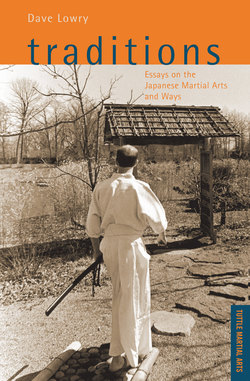Читать книгу Traditions - Dave Lowry - Страница 14
На сайте Литреса книга снята с продажи.
ОглавлениеDeath of a Warrior
When Noritsune
Drowned himself
Three trails of bubbles rose.
This has always been among my favorite senryu, one of the pithy verses of Japanese poetry, rather like the more familiar haiku, which are often keen observations on the human condition. This brief senryu, in three short lines, has much to say about the fighting spirit of the warrior.
Noritsune Noto no kami was a general of the great clan of the Taira, a warrior family bent on the control of the entire country of Japan. In the spring of 1185, the Taira were at the long end of a century-old war with Japan’s other most prominent samurai clan, the Minamoto. Led by Minamoto Yoritomo and his brother Yoshitsune, the Minamoto had dogged the forces of the Taira clan all over southern Japan. They followed the Taira finally into the latter’s stronghold, on the southern island of Shikoku. In a daring attack at dawn, Yoshitsune led a flotilla of boats into the harbor of the town where the Taira were gathered, wreaking havoc, putting most of the town to the torch. The Taira fled to their own ships; a fierce and climactic battle in the struggle between the two clans erupted in the straits of the sea at Dan-o-ura. It would decide for all time which clan would emerge as the most powerful.
Noritsune’s skill as a tactician was legendary, as was his ability in personal combat. He had never lost a battle in which he commanded troops. He was a master archer and an expert with the naginata. In the earlier encounter with the Minamoto, Noritsune had boldly charged, by himself, right up to the enemy lines when he spotted his archrival Yoshitsune in an exposed position. Yoshitsune’s retainers saw Noritsune coming. Quickly, they insinuated themselves between him and their leader. In spite of this human shield, Noritsune, wielding his famous Shigeto bow, fired arrows fletched with hawk feathers at his enemy, dropping eight of the Minamoto samurai surrounding Yoshitsune. One of his targets was pierced from the left shoulder to the right side.
In the final sea battle at Dan-o-ura, Noritsune was a demon. He boarded a Minamoto boat and laid waste to several of the enemy with his long-handled naginata. On the rocking, pitching boats, hand-to-hand combat was breaking out. In the confusion, it was some time before Noritsune caught sight of Yoshitsune. As soon as he did, he charged. But Yoshitsune, who had learned his own martial skills, legend had it, from mountain goblins called tengu, employed a method of jumping in armor that allowed him to leap successfully to another boat. Within the time it took the oarsmen to pull half a dozen strokes, Yoshitsune had once again escaped.
Enraged at the loss of another opportunity to kill Yoshitsune, Noritsune tore off all his armor except for his breastplate, one woven with fine Chinese silk. He shouted to the boats of his enemy, the Minamoto, rocking all around him. “Isn’t there a single warrior among you who wishes to take me on?”
Aki-no-Taro Sanemoto, a Minamoto samurai who was an expert in grappling, took up the challenge. He, his brother Jiro, and another Minamoto retainer launched a small dory-like boat toward the larger vessel where Noritsune waited. They leaped aboard and attacked as a group. With a kick, Noritsune knocked one retainer into the drink. He seized Aki-no-Taro in a wristlock, then grabbed Jiro. “Come on,” he roared, “let’s climb the Mountain of Death!” And with his enemies in tow, he jumped into the foaming swells of the straits.
Three trails of bubbles rose . . .
Noritsune’s sacrifice, like most of the famous sacrifices of the samurai throughout their history, is remembered principally because it was futile. The Taira lost. They lost the battle at Dan-o-ura, and shortly thereafter, they lost the war with the Minamoto entirely. Their clan was doomed. But the spirit of Noritsune is a perfect example of the fighting spirit of the samurai at its best. The violence of combat as it is popularly depicted in modern movies or other forms of fiction tends to be horribly fraudulent. Popular heroes in these take on a whole army of enemies it seems, tackling a regiment of terrorists or a battalion of gangsters or the majority of the adult male population of any country in Southeast Asia. And while our hero may be bloodied a bit or bruised—and his shirt will always be torn—we may be sure that by the time the credits are rolling or the final page has been turned, he will have emerged the victor.
Those of us fortunate enough to have been exposed to the tales of the campaigns between the Taira and the Minamoto when we were kids learned a valuable lesson. We learned that heroes don’t always win. Sometimes, as with Noritsune, they die. They go down, taking as many of the enemy with them as they can—that’s part of what makes them heroes. But they die, nonetheless. In a battle against overwhelming odds, victory is not always possible. But here is the lesson for the warrior: going into a battle with the spirit of Noritsune, with the determination to die and take as many opponents with you as you can, does not guarantee success or victory. You will not always win. Yet with that kind of spirit, can it ever be truly said of you that you lost?
